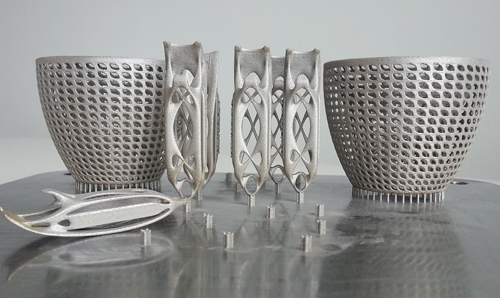3D PRINTING MATERIALS
Direct metal laser sintering
Metal materials available in 3D printing
STAINLESS STEEL - AISI 316L
This very robust material can be used in all industrial sectors (food industries, medical sector (surgical instruments), Energy, Automotive...).
Due to high corrosion resistance, 316L stainless steel is also suitable for the nautical industry (marine components) and cutlery.
3D printing in 316L stainless steel makes possible to manufacture final machined parts, prototypes and durable tools.
TITANIUM - TiAl6V4
The powder based metal Titanium TiAl6V4 3D printing offers an excellent weight/ strength ratio.
This light weight material also has a very good corrosion resistance, allowing it to be adapted to the most demanding and advanced industries (aeronautics, medical, automotive, energy, etc.).
The parts made of Titanium by 3D printing have mechanical properties comparable to a cast manufacture metal part.
It can be used to make prototypes, unique parts, medical devices.
ALUMINUM AISI10MG
AlSi10Mg aluminium is an excellent combination of lightness, strength and price level.
Aluminum, while inexpensive, has good mechanical and thermal properties.However it is less robust at fatigue and high temperatures.
It is used to manufacture prototypes, finished products or parts and production tools.
Direct metal laser sintering (DLMS) - Additive metal manufacturing
Additive metal manufacturing, what benefits?
3D metal printing is intended for industries requiring very robust parts that will serve as a prototype or manufacturing piece resistant, mechanically and stable over time.
It enables complex tooling or final parts to be made and reduces development costs.
3D metal printing technique or additive metal manufacturing
The DLMS works with a very powerful laser that merges small metal particles to form a three dimensional object.
The laser selectively merges fine layers by following the sections generated from a 3D file of the object (for example, a .STL file or a 3d ready to print capture from a 3D scanner).
After merging the layer, the printing tray moves downwards by a distance equal to the exact size it will merge thereafter. A new layer of material is deposited and the process is repeated until the part is finished.
Examples of applications of metallic material additive manufacture
Parts for injection moulds, extrusion tools in light metal or cast iron for application under pressure.

 FRA
FRA ESP
ESP ENG
ENG